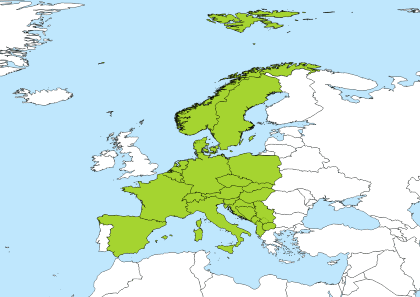PT to CEST Converter
Time Difference
Pacific Daylight Time is 9 hours behind Central European Summer Time
2:30 pm14:30 in PDT is 11:30 pm23:30 in CEST
PT to CEST call time
Best time for a conference call or a meeting is between 8am-10am in PT which corresponds to 6pm-8pm in CEST
2:30 pm14:30 Pacific Daylight Time (PDT). Offset UTC -7:00 hours
11:30 pm23:30 Central European Summer Time (CEST). Offset UTC +2:00 hours
2:30 pm14:30 PDT / 11:30 pm23:30 CEST
| PT | CEST |
|---|---|
| 12am (midnight) | 9am |
| 1am | 10am |
| 2am | 11am |
| 3am | 12pm (noon) |
| 4am | 1pm |
| 5am | 2pm |
| 6am | 3pm |
| 7am | 4pm |
| 8am | 5pm |
| 9am | 6pm |
| 10am | 7pm |
| 11am | 8pm |
| 12pm (noon) | 9pm |
| 1pm | 10pm |
| 2pm | 11pm |
| 3pm | 12am (midnight) |
| 4pm | 1am |
| 5pm | 2am |
| 6pm | 3am |
| 7pm | 4am |
| 8pm | 5am |
| 9pm | 6am |
| 10pm | 7am |
| 11pm | 8am |
| 0:00 | 9:00 |
| 1:00 | 10:00 |
| 2:00 | 11:00 |
| 3:00 | 12:00 |
| 4:00 | 13:00 |
| 5:00 | 14:00 |
| 6:00 | 15:00 |
| 7:00 | 16:00 |
| 8:00 | 17:00 |
| 9:00 | 18:00 |
| 10:00 | 19:00 |
| 11:00 | 20:00 |
| 12:00 | 21:00 |
| 13:00 | 22:00 |
| 14:00 | 23:00 |
| 15:00 | 0:00 |
| 16:00 | 1:00 |
| 17:00 | 2:00 |
| 18:00 | 3:00 |
| 19:00 | 4:00 |
| 20:00 | 5:00 |
| 21:00 | 6:00 |
| 22:00 | 7:00 |
| 23:00 | 8:00 |
Pacific Time
Pacific Time (PT) is a general term used to describe the areas that observe either the Pacific Standard Time (PST) or Pacific Daylight Time (PDT) in the United States and Canada. PT also called Pacific Coast Time. PT is not static but switches between PDT and PST.
Territories observing the Pacific Time Zone are primarily in North America. It runs through the western part of Canada, the United States and the Northwestern part of Mexico.
Countries: It is used in following countries: Canada, Mexico, United States.
Principal Cities: The largest city in the PST timezone is Los Angeles from USA with population about 3.793 million people. Other major cities in the area are Vancouver, Tijuana, San Diego, San Jose.
French: HNP - Heure Normale du Pacifique
Spanish: PT - Tiempo del Pacífico, PT - Zona Noroeste
Pacific Time (PT) is a general term used to describe the areas that observe either the Pacific Standard Time (PST) or Pacific Daylight Time (PDT) in the United States and Canada. PT also called Pacific Coast Time. PT is not static but switches between PDT and PST.
Territories observing the Pacific Time Zone are primarily in North America. It runs through the western part of Canada, the United States and the Northwestern part of Mexico.
Countries: It is used in following countries: Canada, Mexico, United States.
Principal Cities: The largest city in the PST timezone is Los Angeles from USA with population about 3.793 million people. Other major cities in the area are Vancouver, Tijuana, San Diego, San Jose.
French: HNP - Heure Normale du Pacifique
Spanish: PT - Tiempo del Pacífico, PT - Zona Noroeste
PT representations, usage and related time zones
- -08 - basic short
- -0800 - basic
- -08:00 - extended
- -0800 - sign character (-) followed by a four digit time providing hours (08) and minutes (00) of the offset. Indicates eight hour and zero minutes time differences to the west of the zero meridian.
- Uniform - Military abbreviation for PT
- U - short form of 'Uniform'
- Pacific Time - UTC -8
- Ponape Time - UTC +11
- AKDT - Alaska Daylight Time
- PST - Pacific Standard Time
- PT - Pacific Time
- PST - Pitcairn Standard Time
- U - Uniform Time Zone
Central European Summer Time
Offset: CEST is 2 hours ahead Greenwich Mean Time (GMT) and is used in Europe
Countries: It is used in following countries: Andorra, Albania, Austria, Bosnia & Herzegovina, Belgium, Switzerland, Czech Republic, Germany, Denmark, Spain, France, Gibraltar, Croatia, Hungary, Italy, Liechtenstein, Luxembourg, Monaco, Montenegro, North Macedonia, Malta, Netherlands, Norway, Poland, Serbia, Sweden, Slovenia, Svalbard & Jan Mayen, Slovakia, San Marino, Vatican City
Principal Cities: The largest city in the CEST timezone is Berlin from Germany with population about 3.426 million people. Other major cities in the area are Madrid, Rome, Paris, Budapest
German: MESZ - Mitteleuropäische Sommerzeit

Daylight Saving: Central European Summer Time (CEST) is a daylight saving/summer timezone, however during winter some places switch clocks for one hour back and observe Central European Time (CET).
 Start: Central European Summer Time (CEST) started on Sunday, March 30, 2025 at 2:00 am local time and clocks were set one hour forward to Sunday, March 30, 2025, 3:00 am. Daylight saving starts annually the on last Sunday of March
Start: Central European Summer Time (CEST) started on Sunday, March 30, 2025 at 2:00 am local time and clocks were set one hour forward to Sunday, March 30, 2025, 3:00 am. Daylight saving starts annually the on last Sunday of March
 End: Central European Summer Time (CEST) ends on Sunday, October 26, 2025 at 3:00 am local time and clocks are set one hour back to Sunday, October 26, 2025, 2:00 am local standard time instead. Daylight saving ends annually the on last Sunday of October
End: Central European Summer Time (CEST) ends on Sunday, October 26, 2025 at 3:00 am local time and clocks are set one hour back to Sunday, October 26, 2025, 2:00 am local standard time instead. Daylight saving ends annually the on last Sunday of October
CEST representations, usage and related time zones
- +02 - basic short
- +0200 - basic
- +02:00 - extended
- +0200 - sign character (+) followed by a four digit time providing hours (02) and minutes (00) of the offset. Indicates two hour and zero minutes time differences to the east of the zero meridian.
- Bravo - Military abbreviation for CEST
- B - short form of 'Bravo'
- Africa/Ceuta
- Arctic/Longyearbyen
- Atlantic/Jan_Mayen
- CET
- Europe/Amsterdam
- Europe/Andorra
- Europe/Belgrade
- Europe/Berlin
- Europe/Bratislava
- Europe/Brussels
- Europe/Budapest
- Europe/Busingen
- Europe/Copenhagen
- Europe/Gibraltar
- Europe/Ljubljana
- Europe/Luxembourg
- Europe/Madrid
- Europe/Malta
- Europe/Monaco
- Europe/Oslo
- Europe/Paris
- Europe/Podgorica
- Europe/Prague
- Europe/Rome
- Europe/San_Marino
- Europe/Sarajevo
- Europe/Skopje
- Europe/Stockholm
- Europe/Tirane
- Europe/Vaduz
- Europe/Vatican
- Europe/Vienna
- Europe/Warsaw
- Europe/Zagreb
- Europe/Zurich
- MET
- Poland
- CEST - Central European Summer Time
- EET - Eastern European Time
- MESZ - Mitteleuropäische Sommerzeit
- B - Bravo Time Zone
- CAT - Central Africa Time
- IST - Israel Standard Time
- SAST - South Africa Standard Time
- WAST - West Africa Summer Time
